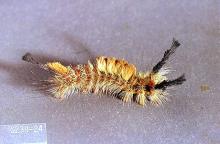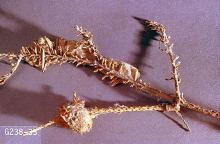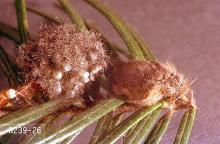Orgyia pseudotsugata
Pest description and crop damage The adult moth flies during the day and is brown to gray, about 1 inch across. Mature larvae are about an inch long, hairy, gray or light brown, with black heads. They are distinguished by three long tufts of black hairs on their body (two in front, one in back) and lighter tufts along their back. The hairs from tussock moth caterpillars break off easily and may cause skin or respiratory irritation. The larvae start at branch tips at the top of the tree and work down, feeding mainly on the new foliage and causing severe defoliation. They may be found under webbing on the branches. The preferred hosts are Douglas-fir, grand fir, and white fir, although it also may be a problem on spruce, pine, and larch. They feed mainly on forest trees and are infrequent pests in the landscape.
Biology and life history The insect overwinters as eggs. The larvae emerge in the spring as buds break and begin feeding on the new growth. The insect pupates in cocoons on the host plant, and adults emerge in summer. The flightless females deposit eggs near the cocoon from which they emerged, usually on the trunk and underside of large branches. There is one generation per year.
Management-biological control
A variety of predators and parasites keep this pest under control most of the time. Severe tussock moth outbreaks are very sporadic and last usually about three years before subsiding.
See:
Biological Control of Nursery Pests
Management-chemical control
See:
Chemical Control of Nursery Pests
For more information
Johnson, W.T. and H.H. Lyon (1991), Insects That Feed on Trees and Shrubs, 2nd ed., Cornell University Press (p. 34).




